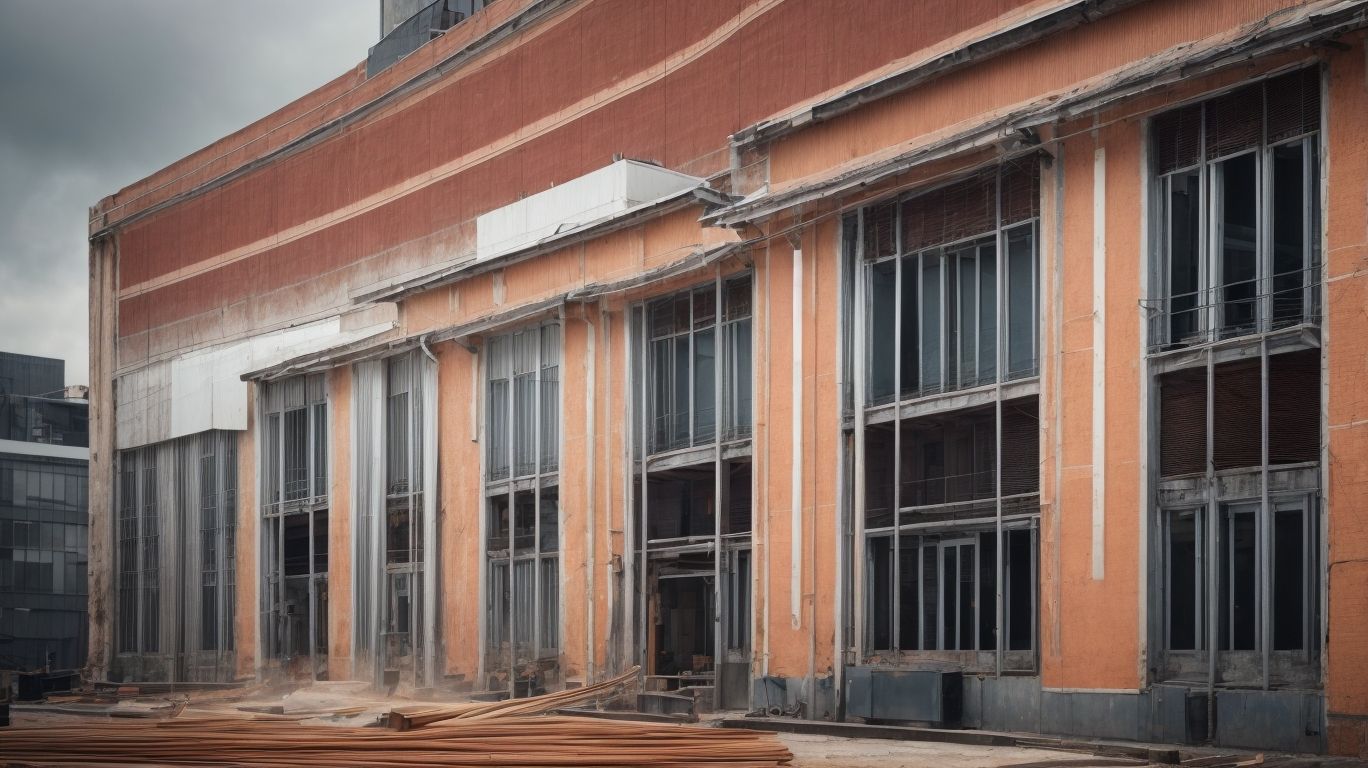
Energy-Efficient Retrofitting: Structural Engineers’ Strategies
Energy-efficient retrofitting is a critical aspect of modern structural engineering, aimed at enhancing the energy performance of existing buildings. This comprehensive guide will delve into the strategies employed by structural engineers to achieve energy efficiency in retrofitting projects. From conducting energy audits to implementing innovative technologies, we will explore the key steps and considerations involved in this process.
We will discuss the importance of energy-efficient retrofitting, its benefits, and the challenges that structural engineers often encounter. By the end of this article, you will gain valuable insights into how structural engineers can overcome these challenges and drive successful energy-efficient retrofitting projects.
What Is Energy-Efficient Retrofitting?
Energy-efficient retrofitting involves the process of upgrading existing buildings or structures to improve their energy performance and sustainability, often through renovation and construction efforts.
This approach aims to address the environmental impact of buildings by implementing modern technologies and techniques that minimize energy consumption and carbon emissions. It plays a crucial role in enhancing building sustainability and performance, leading to reduced operational costs and a smaller carbon footprint. Energy-efficient retrofitting also contributes to providing occupants with a healthier and more comfortable indoor environment while promoting the long-term resilience of the built environment.
Through strategic retrofit initiatives, buildings can align with current sustainability standards and contribute to overall environmental conservation efforts.
Why Is Energy-Efficient Retrofitting Important?
Energy-efficient retrofitting plays a crucial role in reducing energy consumption, minimizing environmental impact, achieving cost savings, and adhering to building codes and regulations.
It helps in transforming existing buildings into sustainable and efficient structures, thereby contributing to a greener environment. By upgrading insulation, installing energy-efficient lighting and HVAC systems, and implementing smart controls, buildings can significantly cut down on energy usage. This not only leads to lower utility bills for the owners but also reduces greenhouse gas emissions, making a positive impact on the environment.
Energy-efficient retrofitting ensures that buildings comply with the latest energy codes and standards, promoting a more sustainable and responsible approach to construction and development.
What Are the Benefits of Energy-Efficient Retrofitting?
Energy-efficient retrofitting offers numerous benefits, including enhanced building performance, effective project management, and the promotion of green building practices that contribute to environmental sustainability.
By improving building performance, energy-efficient retrofitting can lead to reduced energy consumption, lower utility costs, and a more comfortable indoor environment. Efficient project management ensures timely completion and cost-effectiveness, minimizing disruptions to building occupants.
The integration of green building practices not only reduces the environmental impact but also enhances the overall health and well-being of occupants, making it a worthwhile investment for both building owners and the environment.
What Are the Strategies Used by Structural Engineers in Energy-Efficient Retrofitting?
Structural engineers employ a variety of strategies in energy-efficient retrofitting, incorporating innovative building design, advanced materials, enhanced insulation, and upgraded HVAC systems to optimize energy performance.
These professionals focus on implementing building designs that maximize natural light, facilitate effective ventilation systems, and utilize sustainable materials. They prioritize insulation enhancements by integrating high-performance insulation products and technologies to reduce energy consumption. Advancements in HVAC systems are leveraged, incorporating energy-efficient technologies and smart controls for precise temperature and energy management, ultimately contributing to the overall energy-efficient retrofitting process.
Conducting Energy Audits
One key strategy employed in energy-efficient retrofitting is the thorough conduct of energy audits to assess thermal performance and identify opportunities for sustainable design improvements.
This approach is crucial as it helps in understanding the existing energy usage patterns within a building, thereby enabling the identification of potential areas for improvement. Energy audits provide valuable insights into the effectiveness of insulation, HVAC systems, and overall building envelope, allowing for targeted sustainable design enhancements.
Incorporating relevant keywords such as building energy performance, energy management, and renewable energy integration is essential for contextual depth and relevance in the energy audit process.
Improving Building Envelope
Improving the building envelope is a fundamental strategy in energy-efficient retrofitting, involving the implementation of energy efficiency measures and structural improvements to optimize the building’s overall energy performance.
This not only reduces energy consumption and operational costs but also minimizes environmental impact. By enhancing insulation, upgrading windows and doors, and sealing air leaks, the building envelope becomes more airtight, mitigating thermal bridging and heat loss. Incorporating high-performance materials and utilizing advanced construction techniques further contributes to achieving a well-insulated and airtight building envelope. These measures work in synergy to create a sustainable and energy-efficient environment, ensuring long-term benefits for the building occupants and the planet.
Upgrading HVAC Systems
Another critical strategy in energy-efficient retrofitting involves the upgrading of HVAC systems, incorporating energy-saving measures and implementing energy-efficient solutions to enhance overall system performance.
This renovation not only improves indoor air quality and occupant comfort but also helps in reducing energy consumption and operational costs. By integrating smart thermostats, variable refrigerant flow systems, and high-efficiency air filters, the HVAC system can optimize its functionality and perform at peak levels, aligning with the sustainability goals of the building.
The incorporation of energy-efficient solutions such as geothermal heat pumps and energy recovery ventilators can further enhance the system’s performance while reducing its environmental impact.
Utilizing Renewable Energy Sources
The utilization of renewable energy sources is a key strategy in energy-efficient retrofitting, contributing to sustainable construction practices and the integration of energy-efficient materials for enhanced building performance.
This approach not only reduces the carbon footprint of buildings but also promotes energy independence and resilience. Incorporating solar panels, wind turbines, or geothermal systems can significantly lower energy consumption and operational costs. Using eco-friendly building materials, such as recycled steel, sustainable wood products, and energy-efficient insulation, further enhances the overall environmental impact.
By leveraging these sustainable and energy-efficient solutions, buildings can achieve a more sustainable and cost-effective operation, benefiting both the environment and building owners.
Implementing Energy-Efficient Lighting
Implementing energy-efficient lighting solutions is a vital strategy in energy-efficient retrofitting, contributing to sustainable retrofitting practices and the adoption of energy-efficient practices for improved building performance.
By opting for energy-efficient lighting, buildings can significantly reduce their energy consumption, leading to lower utility costs and a reduced environmental footprint. This integrates with the overall aim of sustainable retrofitting practices, aligning with the global emphasis on environmental conservation.
Modern energy-efficient lighting technologies offer improved longevity and quality, minimizing maintenance needs and enhancing the overall efficiency of the building. The seamless integration of energy-efficient lighting further emphasizes the commitment to sustainable, energy-conscious practices.
Insulating Walls and Roofs
A critical strategy employed in energy-efficient retrofitting is the insulation of walls and roofs, utilizing advanced building materials and adhering to energy efficiency standards to optimize overall energy performance.
This approach not only enhances the thermal comfort of the building but also significantly reduces energy consumption and associated costs. Incorporating high-quality insulation materials such as fiberglass, cellulose, or spray foam can effectively minimize heat transfer, thereby maintaining a stable indoor temperature.
Meeting energy efficiency standards ensures that the retrofitting project aligns with sustainable building practices and contributes to reducing the carbon footprint. Such strategic insulation installations play a pivotal role in creating environmentally friendly and economically viable living and working spaces.
Installing Energy-Efficient Windows and Doors
Installing energy-efficient windows and doors is a crucial strategy in energy-efficient retrofitting, contributing to effective building retrofit efforts and incorporating innovative structural design elements for improved energy performance.
These modern windows and doors are designed to minimize energy loss, effectively preventing drafts and heat transfer. By enhancing insulation and reducing air leakage, they play a key role in optimizing the building’s thermal performance. Their impact extends beyond energy conservation, as they also contribute to improved indoor comfort and air quality. Integrating these elements into retrofit projects can lead to long-term savings on energy bills and a reduced environmental footprint.
What Are the Challenges of Energy-Efficient Retrofitting?
Energy-efficient retrofitting presents several challenges, including high upfront costs, potential disruption to occupants, and the need to integrate complex building systems with energy-efficient solutions.
These challenges often deter building owners from pursuing retrofitting projects despite the long-term benefits. The initial investment may seem daunting, especially for older buildings that require extensive upgrades. The process of retrofitting can lead to inconvenience for occupants, disrupting their daily routines. Integrating energy-efficient solutions into existing building systems requires careful planning and coordination to ensure seamless functionality.
Addressing these challenges is crucial for maximizing the potential of energy-efficient retrofitting in the sustainable transformation of buildings and reducing environmental impact.
High Upfront Costs
One significant challenge in energy-efficient retrofitting is the presence of high upfront costs, which must be carefully managed to ensure long-term cost savings through the adoption of energy-efficient construction methods.
This can be mitigated by incorporating cost-saving measures such as using sustainable materials, implementing efficient insulation, and optimizing energy systems. The utilization of energy-efficient construction methods, such as passive solar design and high-performance windows, can significantly reduce long-term operational costs. By integrating these measures, property owners can ultimately maximize their return on investment while contributing to a more sustainable environment.
Disruption to Occupants
Energy-efficient retrofitting may lead to potential disruption to occupants, necessitating effective project management and the implementation of energy-efficient renovation techniques to minimize the impact on building occupants.
It is important for project managers to carefully plan the retrofitting process, considering the needs and comfort of the occupants. Effective communication with building occupants to inform them about the potential disruptions and the timeline of the renovation can help in managing expectations and reducing concerns.
The use of advanced energy-efficient renovation techniques such as smart insulation, efficient HVAC systems, and energy-efficient lighting can significantly reduce the inconveniences experienced by the occupants during the retrofitting process.
Limited Space for Upgrades
Limited space for upgrades poses a notable challenge in energy-efficient retrofitting, requiring comprehensive structural analysis and the development of innovative energy-efficient building design strategies to optimize available space.
This necessitates a thorough evaluation of the existing structural layout to identify opportunities for integration of energy-efficient technologies. Implementing compact yet powerful HVAC systems, utilizing advanced insulation materials, and incorporating smart lighting solutions are pivotal in maximizing energy efficiency within confined spaces.
The strategic placement of windows and renewable energy sources such as solar panels can significantly contribute to creating a sustainable and energy-smart environment within the constraints of limited space.
Finding Skilled Workers
Another challenge in energy-efficient retrofitting is the task of finding skilled workers to execute the necessary project requirements, emphasizing the importance of effective project management and the use of energy-efficient building construction strategies.
This task involves identifying professionals who are well-versed in sustainable building materials and techniques, and who can integrate renewable energy solutions seamlessly into existing structures. Ensuring that the workforce is knowledgeable about energy-efficient technologies and capable of implementing them effectively is crucial.
It also calls for establishing clear communication channels and coordinating various trades involved in the retrofitting process to ensure a seamless and efficient workflow. Project managers need to prioritize training and continuous education to keep the workforce updated on the latest industry practices and technologies.
How Can Structural Engineers Overcome These Challenges?
To address these challenges, structural engineers can employ effective strategies such as conducting thorough cost-benefit analysis, leveraging innovative technologies, and collaborating with skilled contractors to overcome the obstacles in energy-efficient retrofitting.
By conducting a detailed cost-benefit analysis, engineers can determine the most feasible retrofitting options that offer the greatest energy savings with the least investment. Leveraging innovative technologies such as advanced insulation materials, energy-efficient HVAC systems, and smart building automation can significantly enhance the performance of retrofitted buildings. Collaborating with skilled contractors can ensure that the retrofitting process is executed with precision and expertise, optimizing the overall energy efficiency of the structure.
Conducting Thorough Cost-Benefit Analysis
Structural engineers can overcome challenges in energy-efficient retrofitting by conducting thorough cost-benefit analysis, which guides effective decision-making related to energy-efficient building maintenance and design guidelines.
This analysis allows professionals to weigh the upfront costs of retrofitting against the long-term energy savings. By identifying the most cost-effective measures, engineers can prioritize upgrades that offer the highest return on investment.
Considering the impact on building maintenance, it helps in determining the potential reduction in operational expenses and the extension of the building’s lifespan. Ultimately, the cost-benefit analysis acts as a crucial tool for shaping sustainable and efficient building design and maintenance practices.
Communicating with Occupants
Effective communication with occupants is vital for overcoming challenges in energy-efficient retrofitting, ensuring the successful implementation of energy-efficient building retrofit guidelines and minimizing disruptions.
Engaging with occupants during the retrofit process fosters a collaborative environment, encouraging them to embrace the changes and adapt their habits for a more sustainable living experience. By openly discussing the benefits of energy efficiency and involving occupants in decision-making, such as selecting energy-efficient appliances and understanding the importance of insulation, the retrofitting process becomes a shared journey towards a greener future. This cooperative approach enhances overall satisfaction and ultimately contributes to long-term energy savings.
Utilizing Innovative Technologies
The utilization of innovative technologies is essential for overcoming challenges in energy-efficient retrofitting, facilitating the adoption of advanced energy-efficient building construction methods and design principles.
These technologies provide opportunities to incorporate sustainable and eco-friendly materials, such as photovoltaic panels, advanced insulation, and smart energy management systems. By integrating these elements, building design can prioritize natural lighting, ventilation, and temperature control, leading to reduced energy consumption. The use of cutting-edge construction techniques, like modular and prefabricated components, further enhances the efficiency of retrofitting processes while minimizing environmental impact. Embracing these innovative technologies in retrofitting is crucial for creating sustainable buildings that align with modern energy standards and environmental considerations.
Collaborating with Skilled Contractors
Collaborating with skilled contractors is a key strategy for overcoming challenges in energy-efficient retrofitting, ensuring the implementation of effective energy-efficient building maintenance practices and design guidelines.
By leveraging the expertise of experienced contractors, building owners can navigate the complexities of retrofitting projects with precision and proficiency. This collaboration facilitates the seamless integration of innovative technologies and sustainable solutions, elevating the overall energy performance of the building.
Skilled contractors can provide valuable insights into the latest industry standards and best practices, empowering stakeholders to make informed decisions that align with long-term sustainability objectives.




No Comments